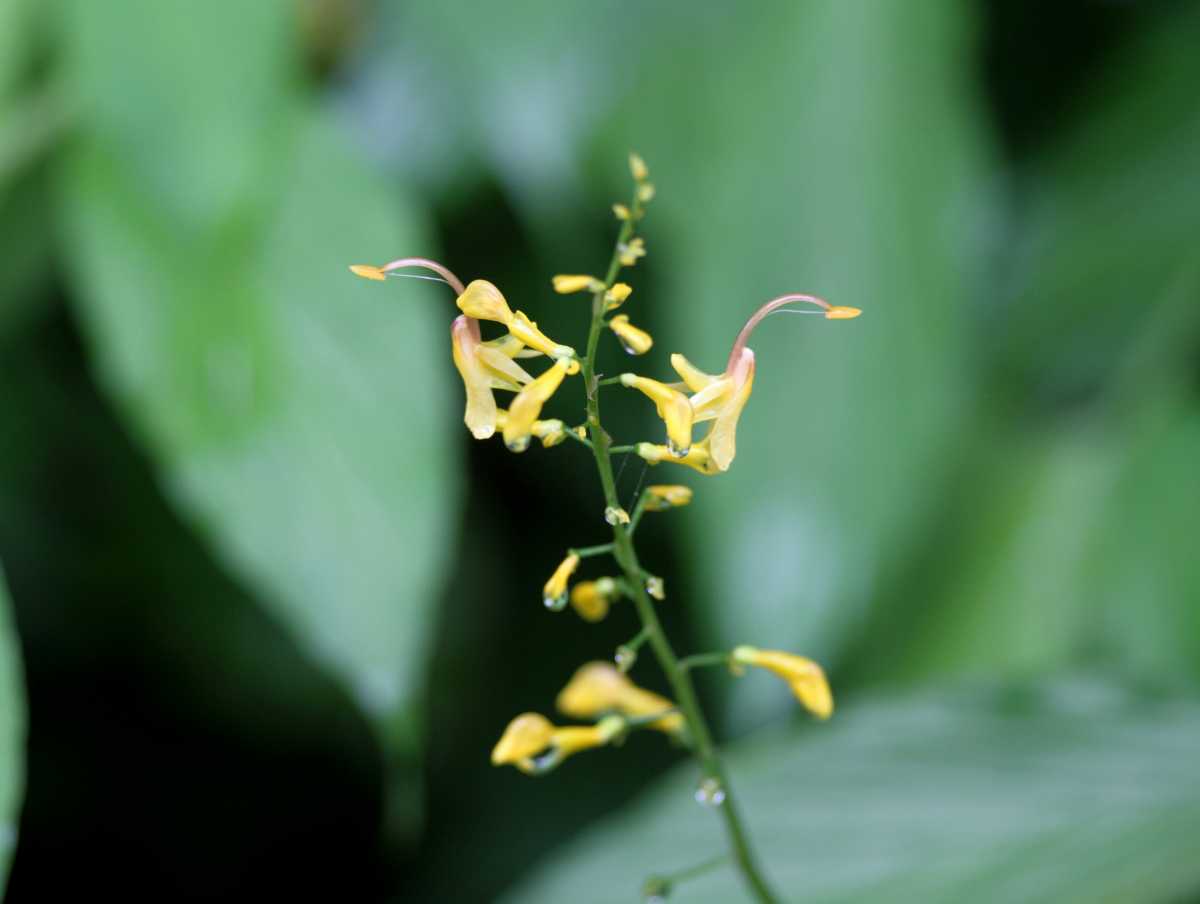|
Zingiberaceae
Zingiberaceae () or the ginger family is a family of flowering plants made up of about 50 genera with a total of about 1600 known species of aromatic perennial herbs with creeping horizontal or tuberous rhizomes distributed throughout tropical Africa, Asia, and the Americas. Many of the family's species are important ornamental, spice In the culinary arts, a spice is any seed, fruit, root, Bark (botany), bark, or other plant substance in a form primarily used for flavoring or coloring food. Spices are distinguished from herbs, which are the leaves, flowers, or stems of pl ..., or medicinal plants. Ornamental genera include the shell gingers ('' Alpinia''), Siam or summer tulip ('' Curcuma alismatifolia''), '' Globba'', ginger lily ('' Hedychium''), '' Kaempferia'', torch-ginger '' Etlingera elatior'', '' Renealmia'', and ginger ('' Zingiber''). Spices include ginger ('' Zingiber''), galangal or Thai ginger ('' Alpinia galanga'' and others), melegueta pepper ('' Aframo ... [...More Info...] [...Related Items...] OR: [Wikipedia] [Google] [Baidu] |
Renealmia
''Renealmia'' is a plant genus in the family Zingiberaceae. Its members are native to tropical Africa and tropical America (Latin America and the West Indies). In Peru, fruits and tubers are sources of indigenous dyes. and indigenous medical treatments for leishmania and malaria In Colombia, it is used to treat snakebite. Bracts and leaves can serve as phytotelmata, retaining small quantities of water that offer habitat for other organisms.Hayford, B., T. Förster, V. Patel, & C. S. Chaboo. 2021. Aquatic Diptera associated with Neotropical Zingiberales phytotelmata (Diptera). Journal of Natural History 54:43-44, 2815-2838. Species include: * '' Renealmia acreana'' Maas - Brazil (Acre State) * '' Renealmia africana'' Benth. - western and central Africa from Togo to Angola * '' Renealmia alborosea'' K.Schum. in H.G.A.Engler - Cameroon * ''Renealmia alpinia ''Renealmia alpinia'' is a flowering plant species native to the Americas, where it grows from southern Mexico through much ... [...More Info...] [...Related Items...] OR: [Wikipedia] [Google] [Baidu] |
Zingiber
''Zingiber'' is a genus of flowering plants in the family Zingiberaceae. It is native to China, the Indian subcontinent, New Guinea, and Southeast Asia, especially Thailand. It contains the true gingers, plants grown the world over for their culinary value. The most well known species are '' Z. officinale'' and '' Z. mioga'', two garden gingers. The genus name comes from Latin borrowing the Tamil name for the first species. Culinary Each ginger species has a different culinary usage; for example, myoga is valued for the stem and flowers. Garden ginger's rhizome is the classic spice "ginger", and may be used whole, candied (known commonly as crystallized ginger), or dried and powdered. Other popular gingers used in cooking include cardamom and turmeric, though neither of these examples is a "true ginger" – they belong to different genera in the family Zingiberaceae. Species ''Plants of the World Online'' currently includes: # ''Zingiber acuminatum'' Valeton # ''Zingibe ... [...More Info...] [...Related Items...] OR: [Wikipedia] [Google] [Baidu] |
Kaempferia
''Kaempferia'' is a genus of plants in the ginger family. It is native to China, India, and Southeast Asia. The genus is named after the naturalist and traveller Engelbert Kaempfer, who lived in Japan and east Asia for the years 1689-1693 and was one of the first Europeans to write detailed descriptions of plants there. Species Over 100 names have been proposed in the genus. The following are accepted: * '' Kaempferia alboviolacea'' Ridl. - Vietnam * '' Kaempferia angustifolia'' Roscoe - Bangladesh, Assam, Vietnam, Thailand, Sumatra * '' Kaempferia attapeuensis'' Picheans. & Koonterm - Laos * '' Kaempferia champasakensis'' Picheans. & Koonterm - Laos * '' Kaempferia chayanii'' Koonterm - Laos * '' Kaempferia cuneata'' Gagnep. - Vietnam * '' Kaempferia elegans'' (Wall.) Baker in J.D.Hooker - Sichuan, Indochina, Borneo * '' Kaempferia evansii'' Blatt. - southern India * '' Kaempferia fallax'' Gagnep. - Laos, Thailand * '' Kaempferia filifolia'' K.Larsen - Thailand * '' Kaempferi ... [...More Info...] [...Related Items...] OR: [Wikipedia] [Google] [Baidu] |
Hedychium
''Hedychium'' is a genus of flowering plants in the ginger family Zingiberaceae, native to lightly wooded habitats in Asia. There are approximately 70-80 known species, native to India, Southeast Asia, and Madagascar. Some species have become widely naturalized in other lands, and considered invasive in some places. The genus name ''Hedychium'' is derived from two ancient Greek words, meaning "sweet" and meaning "snow". This refers to the fragrant white flower of the type species '' H. coronarium''. Common names include garland flower, ginger lily, and kahili ginger. Members of the genus ''Hedychium'' are rhizomatous perennials, commonly growing tall. Some species are cultivated for their exotic foliage and fragrant spikes of flowers in shades of white, yellow and orange. Numerous cultivars have been developed for garden use, of which 'Tara' has gained the Royal Horticultural Society's Award of Garden Merit. Though reasonably hardy down to , it requires a sheltered position ... [...More Info...] [...Related Items...] OR: [Wikipedia] [Google] [Baidu] |
Alpinia
''Alpinia'' is a genus of flowering plants in the ginger family, Zingiberaceae. Species are native to Asia, Australia, and the Pacific Islands, where they occur in tropical and subtropical climates.''Alpinia''. Flora of China. Several species are cultivated as s.''Alpinia''. Flora of North America. Taxonomy The genus was erected by the Scottish botanist ...[...More Info...] [...Related Items...] OR: [Wikipedia] [Google] [Baidu] |
Galangal
Galangal () is a rhizome of plants in the ginger family Zingiberaceae, with culinary and medicinal uses originating in Indonesia. It is one of four species in the genus ''Alpinia'', and is known for its pungent, aromatic flavor. Greater galangal (''Alpinia galanga'') is most commonly used, and is similar to ginger and turmeric. It is native to South Asia and Southeast Asia. Lesser galangal (''Alpinia officinarum'') and other types are also used, though less frequently. In traditional medicine, galangal is used to treat various ailments. It is a common ingredient in Thai, Indonesian, and Malaysian cuisine, and is also used in some traditional Chinese medicine. Differentiation The word ''galangal'', or its variant ''galanga'' or archaically ''galingale'', can refer in common usage to the aromatic rhizome of any of four plant species in the Zingiberaceae (ginger) family, namely: * ''Alpinia galanga'', also called ''greater galangal'', ''lengkuas'', ''Siamese ginger'' or ''laos' ... [...More Info...] [...Related Items...] OR: [Wikipedia] [Google] [Baidu] |
Etlingera Elatior
''Etlingera elatior'' (also known as torch ginger, among other names) is a species of herbaceous perennial plant in the family Zingiberaceae; it is native to Indonesia, Thailand, Malaysia and New Guinea. The showy pink flowers are used in decorative arrangements, and are an important ingredient in food across Southeast Asia. Names ''E. elatior'' is also known as "torch ginger", "ginger flower", "red ginger lily", "torchflower", "torch lily", "wild ginger", "Indonesian tall ginger" and "porcelain rose". (); ; ; (). Description The species grows as a pseudostem from a rhizome; it takes about 18–22 days for the first leaf to grow from the rhizome. The leafy shoot lasts for about 70 days and may reach a height of 3–4 metres. Its leaves are leathery and grow around long with a central groove. The fibers of ''Etlingera elatior'' are strong. Flower The flower bud appears from the shoot after 30 days, it swells gradually and turns pink before blooming after more than 50 ... [...More Info...] [...Related Items...] OR: [Wikipedia] [Google] [Baidu] |
Turmeric
Turmeric (), or ''Curcuma longa'' (), is a flowering plant in the ginger family Zingiberaceae. It is a perennial, rhizomatous, herbaceous plant native to the Indian subcontinent and Southeast Asia that requires temperatures between and high annual rainfall to thrive. Plants are gathered each year for their rhizomes, some for propagation in the following season and some for consumption or dyeing. The rhizomes can be used fresh, but they are often boiled in water and dried, after which they are ground into a deep orange-yellow shelf-stable spice powder commonly used as a coloring and flavoring agent in many Asian cuisines, especially for curries ( curry powder). Turmeric powder has a warm, bitter, black pepper-like flavor and earthy, mustard-like aroma. Although long used in Ayurvedic medicine, there is no high-quality clinical evidence that consuming turmeric or the principal turmeric constituent, curcumin, is effective for treating any disease. Curcumin, a bright ye ... [...More Info...] [...Related Items...] OR: [Wikipedia] [Google] [Baidu] |
Korarima
''Aframomum corrorima'' is a species of flowering plant in the ginger family, Zingiberaceae. It is an herbaceous perennial that produces leafy stems 1–2 meters tall from rhizomatous roots. The alternately-arranged leaves are dark green, 10–30 cm long and 2.5–6 cm across, elliptical to oblong in shape. Pink flowers are borne near the ground and give way to red, fleshy fruits containing shiny brown seeds, which are typically 3–5 mm in diameter. The spice, known as Ethiopian cardamom, false cardamom, or ''korarima'', is obtained from the plant's seeds (usually dried), and is extensively used in Ethiopian and Eritrean cuisine. It is an ingredient in ''berbere'', ''mitmita'', ''awaze'', and other spice mixtures, and is also used to flavor coffee. Its flavor is comparable to that of the closely related ''Elettaria cardamomum'' or green cardamom. In Ethiopian herbal medicine, the seeds are used as a tonic, carminative, and laxative. The plant is native to Tanza ... [...More Info...] [...Related Items...] OR: [Wikipedia] [Google] [Baidu] |
Globba
''Globba'' is a genus of plants in the ginger family: with delicate flowers, sometimes called "dancing ladies" or "dancing girls ginger". Species are native to the Indian Subcontinent, China, Southeast Asia, New Guinea, the Bismarck Archipelago and Queensland.Plants of the World Online: ''Globba'' L. (retrieved 19 October 2024) /ref> Species [...More Info...] [...Related Items...] OR: [Wikipedia] [Google] [Baidu] |
Elettaria
''Elettaria'' is a genus of flowering plants in the family Zingiberaceae. They are native to India and Sri Lanka, but cultivated and naturalized elsewhere. One member of the genus, '' E. cardamomum'', is a commercially important spice used as a flavouring agent in many countries. In 2018, several species were removed from ''Elettaria'' and placed in a new genus called '' Sulettaria''. These species are recognized as of October 2018: * '' Elettaria cardamomum'' (L.) Maton - India * '' Elettaria ensal'' (Gaertn.) Abeyw. - Sri Lanka These former species from Malaysia and Indonesia Indonesia, officially the Republic of Indonesia, is a country in Southeast Asia and Oceania, between the Indian Ocean, Indian and Pacific Ocean, Pacific oceans. Comprising over List of islands of Indonesia, 17,000 islands, including Sumatra, ... were reclassified into '' Sulettaria'' in 2018: * '' Elettaria brachycalyx'' S.Sakai & Nagam. - Sarawak * '' Elettaria kapitensis'' S.Sakai & Nagam. ... [...More Info...] [...Related Items...] OR: [Wikipedia] [Google] [Baidu] |
Amomum
''Amomum'' is a genus of plants containing about 111 species native to China, the Indian subcontinent, Southeast Asia, New Guinea, and Queensland. It includes several species of cardamom. Plants of this genus are remarkable for their pungency and aromatic properties. Among ancient writers, the name ''amomum'' was ascribed to various odoriferous plants that cannot be positively identified today. The word derives from Latin ''amomum'', which is the latinisation of the Greek ἄμωμον (''amomon''), a kind of an Indian spice plant. Henry George Liddell, Robert Scott, ''A Greek-English Lexicon'', on Perseus Digital Library Edmund Roberts noted on his 1834 trip to China ... [...More Info...] [...Related Items...] OR: [Wikipedia] [Google] [Baidu] |



